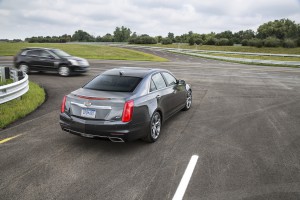
By 2017, the Cadillac CTS will be equipped with V2V technology, which tells the driver about coming vehicles before they can be seen and avoiding a collision.
While flying cars, a la The Jetsons, didn’t zip around Detroit this week, much of what was predicted for future motorists did make an appearance during the 2014 ITS World Congress.
More than 10,000 people trekked to conference that focused on a theme of “Reinventing Transportation in our Connected World.” Showgoeers saw a plethora of “intelligent” vehicles with capabilities ranging from simply improving driver reflexes to removing the driver from the equation entirely.
Honda’s idea of semi-autonomous driving revolves around a prototype Acura RLX sedan using cameras to monitor lane markings and radar sensors on the front and sides of the vehicle.
Once in traffic, the vehicle could keep pace with the vehicles around it as well as make any emergency decisions, such as bringing the vehicle to a stop or avoiding an object in the road, and more while the driver simply relaxed.
Using a predetermined eight-mile-long route on Detroit roadways, the prototype accelerated to the speed limit on the freeway without the driver’s help. It signaled to switch lanes, knowing when there was an opening.
It merged onto two additional freeways, avoided a construction zone and braked when it got too close to the car in front of it all without any input from the driver. While a very capable vehicle, the Japanese maker said the car will automatically return control to the driver if it is unable to handle a scenario such as being cut off in traffic suddenly. The company’s been developing the car for the better part of a year.
Honda’s vehicle was just one of several prototypes traversing the Motor City this week during the show, which is now winding down.
In addition to Honda, General Motors, BMW and Toyota displayed vehicles with varying degrees of self-driving capabilities, providing a glimpse into the future. The somewhat near future in fact, as GM’s CEO, Mary Barra, kicked off the event by announcing Cadillac will be the maker’s first brand to be nearly autonomous by 2017 and putting forth the goal of eliminating crashes altogether, mirroring Toyota’s stated goal from a week earlier.
(Safer cars could mean trading off privacy. For more, Click Here.)
The show wasn’t just a what’s what of techie cars and trucks, but also a chance to see the newest plans for V2I and V2V communications. In fact, the Michigan Department of Transportation this week announced plans to create a vehicle-to-infrastructure communications network along 120 miles of Detroit-area highways.
(Click Here for details on Toyota’s plans to open a plant in Mexico.)
National Highway Traffic Safety Administration Administrator David Friedman said V2I communications had the potential to save “thousands of lives” annually during his appearance at the event.
The show also gave attendees a chance to start sorting through some difficult questions related to this technology, such as:
- What will be done with all of the data collected by these systems?
- How will privacy be impacted?
- What can be done to drive down the price of this technology?
- Who gets the ticket when driving an autonomous vehicle?
- And perhaps most importantly: who is going to pay for all this automation?
Friedman addressed the issue of cybersecurity on the newly automated vehicles during his time in Detroit suggesting that no one maker should have the security market cornered.
(To see more about Montezemolo’s impact at Ferrari, Click Here.)
“Certain things about safety should not be at all about competitive advantage,” Friedman said. “I think cybersecurity is one of those perfect examples where sharing information will ensure that everyone is better off.”
Next year’s event will be October 5-9 in Bordeaux, France.
